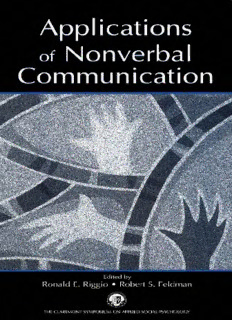
Applications of Nonverbal Communication PDF
Preview Applications of Nonverbal Communication
Applications of Nonverbal Communication TLFeBOOK THE STAUFFER SYMPOSIUM ON APPLIED PSYCHOLOGY AT THE CLAREMONT COLLEGES This series of volumes highlights important new developments on the leading edge of applied social psychology. Each volume focuses on one area in which social psychological knowledge is being applied to the resolution of social problems. Within that area, a distin- guished group of authorities present chapters summarizing recent theoretical views and empirical findings, including the results of their own research and applied activities. An introductory chapter frames the material, pointing out common themes and varied areas of practical applications. Thus each volume brings together tren- chant new social psychological ideas, research results, and fruitful applications bearing on an area of current social interest. The vol- umes will be of value not only to practitioners and researchers, but also to students and lay people interested in this vital and expanding area of psychology. Series books published by Lawrence Erlbaum Associates: • Reducing Prejudice and Discrimination, edited by Stuart Oskamp (2000). • Mass Media and Drug Prevention: Classic and Contemporary Theories and Research, edited by William D. Crano and Michael Burgoon (2002). • Evaluating Social Programs and Problems: Visions for the New Millennium, edited by Steward I. Donaldson and Michael Scriven (2003). • Processes of Community Change and Social Action, edited by Allen M. Omoto and Stuart Oskamp (2004). • Applications of Nonverbal Communication, edited by Ronald E. Riggio and Robert S. Feldman (2005). Applications of Nonverbal Communication Edited by Ronald E. Riggio Claremont McKenna College Robert S. Feldman University of Massachusetts, Amherst The Claremont Symposium on Applied Social Psychology LEA LAWRENCE ERLBAUM ASSOCIATES, PUBLISHERS 2005 Mahwah, New Jersey London Copyright © 2005 by Lawrence Erlbaum Associates, Inc. All rights reserved. No part of this book may be reproduced in any form, by photostat, microform, retrieval system, or any other means, without prior written permission of the publisher. Lawrence Erlbaum Associates, Inc., Publishers 10 Industrial Avenue Mahwah, New Jersey 07430 Cover design by Kathryn Houghtaling Lacey Library of Congress Cataloging-in-Publication Data Claremont Symposium on Applied Social Psychology (2003) Applications of nonverbal communication : edited by Ronald E. Riggio, Robert S. Feldman. p. cm. Includes bibliographical references and index. ISBN 0-8058-4334-5 (cloth : alk. paper) ISBN 0-8058-4335-3 (pbk. : alk. paper) 1. Nonverbal communication—Congresses. I. Riggio, Ronald E. II. Feldman, Roberts. (RobertStephen), 1947- . III.Title. P99.5.C58 2003 302.2'22—dc22 2004050673 CIP Books published by Lawrence Erlbaum Associates are printed on acid-free paper, and their bindings are chosen for strength and durability. Printed in the United States of America 10 9 8 7 6 5 4 3 21 Dedication This book is dedicated to Robert Rosenthal and Paul Ekman, for their pioneering work that inspired much of this research. This page intentionally left blank Contents Preface ix Introduction to Applications of Nonverbal Communication xi Ronald E. Riggio and Robert S. Feldman I. Health Applications I Nonverbal Communication and Health Care 3 Leslie Martin and Howard S. Friedman 1 Facial Expression Decoding Deficits in Clinical Populations 17 with Interpersonal Relationship Dysfunctions Pierre Philippot, Celine Douilliez, Thierry Pham, Marie-Line Foisy and Charles Kornreich II. Applications to Law and Politics 3 Nonverbal Communication in the Courtroom 41 and the "Appearance" of Justice Michael Searcy, Steve Duck and Peter Blanck 4 Police Use of Nonverbal Behavior as Indicators of Deception 63 Aldert Vrij and Samantha Mann VII viii CONTENTS 5 Nonverbal Behavior and Political Leadership 97 Al Goethals III. Applications to Business and Education 6 Business Applications of Nonverbal Communication 121 Ronald E. Riggio 1 Working on a Smile: Responding to Sexual Provocation 141 in the Workplace Julie A. Woodzicka and Marianne LaFrance 8 No More Teachers' Dirty Looks: Effects of Teacher Nonverbal 161 Behavior on Student Outcomes Monica Harris and Robert Rosenthal IV. Social and Cultural Issues 9 Withdrawal in Couple Interactions: Exploring the Causes 199 and Consequences Patricia Noller, Judith A. Feeney, Nigel Roberts and Andrew Christensen \ 0 Emotional Intelligence and Deception Detection: Why Most 219 People Can't "Read" Others, But a Few Can Maureen O'Sullivan I I Culture and Applied Nonverbal Communication 259 David Matsumoto and Seung Hee Yoo About the Authors 283 Author Index 287 Subject Index 301 Preface: Applications of Nonverbal Communication Each and every day, in every social interaction, we communicate our feelings, attitudes, thoughts, and concerns nonverbally. Nonverbal communication is used to convey power and status, it is used to ex- press love and intimacy, it is used to communicate agreement, to es- tablish rapport, and to regulate the flow of communication. Nonverbal communication is pervasive, ongoing, and it is part of virtually every human endeavor. The scientific study of nonverbal communication began more than 125 years ago, with the pioneering work of Charles Darwin and his book, The Expression of the Emotions in Man and Animals (1872). A check of the PsycINFO database (beginning coincidentally in 1872) shows nearly 20,000 entries with the subject heading "nonverbal." However, despite this long and rigorous line of research, we still are quite limited in our ability to apply much of this research to important "real world" settings. Much of what researchers have discovered about nonverbal communication remains in professional journals, read and studied only by other researchers of nonverbal communication. This volume provides a much-needed bridge between the research on nonverbal communication and the application of these research findings. In this volume, some of the leading researchers in the field apply their work to understanding nonverbal communication pro- cesses in hospitals and clinics, in courtrooms and police stations, in the workplace and in government, in the classroom, and in everyday settings. It explores nonverbal communication in public settings, in in- timate interpersonal relationships, and across cultures. It is our hope that practitioners of all types, from healthcare workers, to law enforce- ix
Description: